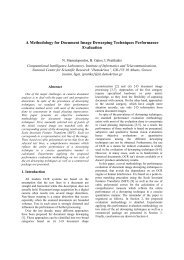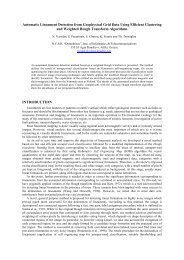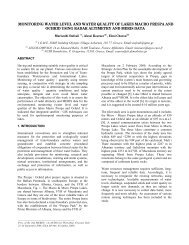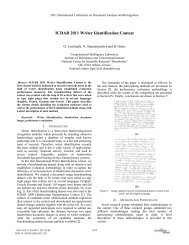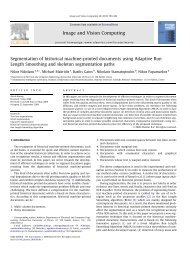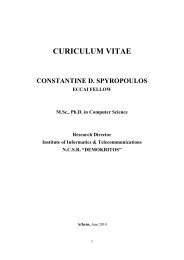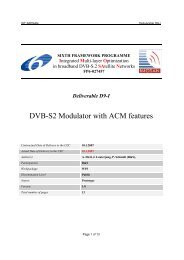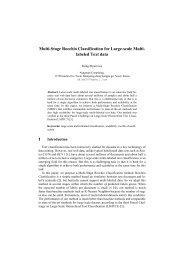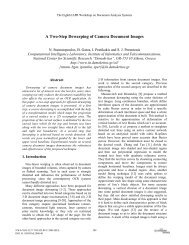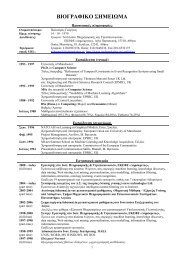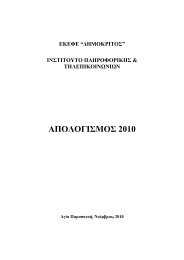TMS320C6713B Floating-Point Digital Signal Processor (Rev. A)
TMS320C6713B Floating-Point Digital Signal Processor (Rev. A)
TMS320C6713B Floating-Point Digital Signal Processor (Rev. A)
You also want an ePaper? Increase the reach of your titles
YUMPU automatically turns print PDFs into web optimized ePapers that Google loves.
SPRS294A − OCTOBER 2005 − REVISED NOVEMBER 2005<br />
PLL and PLL controller (continued)<br />
The PLL Reset Time is the amount of wait time needed when resetting the PLL (writing PLLRST=1), in order<br />
for the PLL to properly reset, before bringing the PLL out of reset (writing PLLRST = 0). For the PLL Reset Time<br />
value, see Table 33. The PLL Lock Time is the amount of time from when PLLRST = 0 with PLLEN = 0 (PLL<br />
out of reset, but still bypassed) to when the PLLEN bit can be safely changed to “1” (switching from bypass to<br />
the PLL path), see Table 33 and Figure 15.<br />
Under some operating conditions, the maximum PLL Lock Time may vary from the specified typical value. For<br />
the PLL Lock Time values, see Table 33.<br />
Table 33. PLL Lock and Reset Times<br />
MIN TYP MAX UNIT<br />
PLL Lock Time 75 187.5 µs<br />
PLL Reset Time 125 ns<br />
Table 34 shows the device’s CLKOUT signals, how they are derived and by what register control bits, and what<br />
is the default settings. For more details on the PLL, see the PLL and Clock Generator Logic diagram (Figure 15).<br />
CLOCK OUTPUT<br />
SIGNAL NAME<br />
CLKOUT2<br />
Table 34. CLKOUT <strong>Signal</strong>s, Default Settings, and Control<br />
DEFAULT SETTING<br />
(ENABLED or DISABLED)<br />
ON (ENABLED)<br />
CONTROL<br />
BIT(s) (Register)<br />
D2EN = 1 (PLLDIV2.[15])<br />
CK2EN = 1 (EMIF GBLCTL.[3])<br />
DESCRIPTION<br />
SYSCLK2 selected [default]<br />
CLKOUT3 ON (ENABLED) OD1EN = 1 (OSCDIV1.[15]) Derived from CLKIN<br />
SYSCLK3 selected [default].<br />
ECLKOUT<br />
ON (ENABLED);<br />
derived from SYSCLK3<br />
EKSRC = 0 (DEVCFG.[4])<br />
EKEN = 1 (EMIF GBLCTL.[5])<br />
To select ECLKIN source:<br />
EKSRC = 1 (DEVCFG.[4]) and<br />
EKEN = 1 (EMIF GBLCTL.[5])<br />
The input clock (CLKIN) is directly available to the McASP modules as AUXCLK for use as an internal<br />
high-frequency clock source. The input clock (CLKIN) may also be divided down by a programmable divider<br />
OSCDIV1 (/1, /2, /3, ..., /32) and output on the CLKOUT3 pin for other use in the system.<br />
Figure 15 shows that the input clock source may be divided down by divider PLLDIV0 (/1, /2, ..., /32) and then<br />
multiplied up by a factor of x4, x5, x6, and so on, up to x25.<br />
Either the input clock (PLLEN = 0) or the PLL output (PLLEN = 1) then serves as the high-frequency reference<br />
clock for the rest of the DSP system. The DSP core clock, the peripheral bus clock, and the EMIF clock may<br />
be divided down from this high-frequency clock (each with a unique divider) . For example, with a 30 MHz input<br />
if the PLL output is configured for 450 MHz, the DSP core may be operated at 225 MHz (/2) while the EMIF may<br />
be configured to operate at a rate of 75 MHz (/6). Note that there is a specific minimum and maximum reference<br />
clock (PLLREF) and output clock (PLLOUT) for the block labeled PLL in Figure 15, as well as for the DSP core,<br />
peripheral bus, and EMIF. The clock generator must not be configured to exceed any of these constraints<br />
(certain combinations of external clock input, internal dividers, and PLL multiply ratios might not be supported).<br />
See Table 35 for the PLL clocks input and output frequency ranges.<br />
78 POST OFFICE BOX 1443 • HOUSTON, TEXAS 77251−1443



